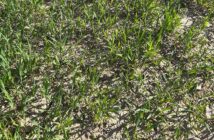Be prepared to protect cereal yields against possible unexpected increases in disease from the important flag leaf (T2) timing onwards.
That is the message from Syngenta fungicide technical manager, Jason Tatnell, who says Syngenta risk modelling has seen a sudden rise in septoria spore levels for those areas that have seen rain events.
“The key point to remember about T2 is that its purpose is to protect crop green leaf area against disease during the critical yield-building phase,” says Mr Tatnell. “There might be 10 weeks between T2 in May and harvest, and every extra day that winter wheat flag leaf green area can be kept above 37%, yield increases by 0.15t/ha.
“For greater yield certainty, the T2 fungicide therefore not only needs to provide powerful disease control but also long-lasting protection. Growers only need to look back to June 2019 when downpours sparked a sudden septoria onslaught in what had previously been a low season.”
Mr Tatnell says the arrival of Miravis Plus last season set new standards for yield in septoria situations.
Now, new trials from 2024 have underlined yield responses, and should give growers extra confidence, he adds.
“Pre-launch trials between 2020 and 2023 showed a Miravis Plus-based treatment delivered in the range of 0.3 to 0.5t/ha over competitor fungicides, with this performance advantage confirmed in the most recent AHDB fungicide performance results.
“Usefully, a T2 application of Miravis Plus + Era (prothioconazole) in wheat has also resulted in reduction in fusarium head blight and in DON mycotoxin. Using Miravis Plus + Era at T2 can make it more likely that a suitable T3 fungicide will keep the crop below a DON threshold. If rust is a concern, this can easily be targeted by adding Amistar (azoxystrobin).”




